Содержание
- 2. This Lecture How to contact me Module material Reference book Lectures and assessment Module overview The
- 3. About me: Higher Education : 2009-2013: International Information Technology University (Almaty, Kazakhstan) 2014 – Newcastle University
- 4. How to contact me Before/ after lectures In the lab Office 802 is NOT an option!
- 5. Module material dl.iitu.kz (Look for Database) Slides for every session will be available A number of
- 6. Course policy Students are forbidden to: submit any tasks after the deadline. Late submissions are graded
- 7. Lectures and Assessments Lecture – once a week Lab sessions – three times a week Assessments
- 8. Learning and feedback Lectures and lab sessions are extremely important ‒Not everything I say is in
- 9. What is Database “A collection of data arranged for ease and speed of search and retrieval.”
- 10. Why we study database? Databases are important for computing ‒ Many computing applications deal with large
- 11. Databases are (virtually) everywhere! • Library catalogues • Medical records • Bank accounts • Stock market
- 12. Example of modern database • Database Management System (DBMS) ‒ The software that implements a database
- 13. Relational algebra first described by E.F. Codd while at IBM, is a family of algebras with
- 14. Relational Data Structure Data is stored in relations (tables) Relations are made up of attributes (columns)
- 15. Relations We will use tables to represent relations This is an example relation between people and
- 16. Relations In general, each column has a domain, a set from which all possible values for
- 17. Relations A mathematical relation is a set of tuples: sequences of values. Each tuple represents a
- 18. Terminology Degree of a relation: how long each tuple is, or how many columns the table
- 19. Mathematical Definition The mathematical definition of a relation R of degree n, where values come from
- 20. Data Manipulation 10 Data is represented as relations Manipulation of this data (through updates and queries)
- 21. Union Standard set-theoretic definition of union: A ∪ B = {x: x ∈ A or x
- 22. Union-compatible Relations Two relations R and S are union- compatible if: They have the same number
- 23. Example 1: Union-compatible? YES! Same number of columns and matching domains
- 24. Example 2: Union-compatible? NO! Different numbers of columns
- 25. Example 3: Union-compatible? NO! Corresponding columns have different domains
- 26. Unions of Relations Let R and S be two union-compatible relations. The Union R ∪ S
- 27. Union Example
- 28. Difference of Relations Let R and S be two union-compatible relations. The difference R - S
- 29. Difference Example
- 30. Intersection of Relations 20 Let R and S be two union-compatible relations. The intersection R ∩
- 31. Intersection Example
- 32. Cartesian Product Cartesian product is a total operation on relations. Can be applied to relations of
- 33. Extended Cartesian Product Extended Cartesian product flattens the result into a single tuple. For example: This
- 34. Extended Cartesian Product of Relations Let R be a relation with column domains {A1,...,An} and S
- 35. Product Example
- 36. Projection Sometimes using all columns in a relation is unnecessary Let R be a relation with
- 37. Projection Example
- 38. Selection Sometimes we want to select tuples based on one or more criteria Let R be
- 39. Comparison Properties We assume that properties are written using {and, or, not} and expressions of the
- 40. Meaningful Comparisons 30 Comparisons between values can only take place where it makes sense to compare
- 41. Selection Example σcol(3)
- 42. Selection Example σcol(3)
- 43. Selection Example σcol(3)
- 44. Selection Example σcol(3)
- 45. Other Operations Not all SQL queries can be translated into relational algebra operations defined in this
- 46. Take home messages Relational Model Relations ‒ Tuples, attributes, domain Terminology Degree, cardinality Data manipulation Set
- 47. This Lecture in Exams What is the result of the following operation? π1,3(σcol(2) = col(4)(R x
- 48. The Relational Model
- 49. This lecture The Relational Model More on Relations Relational data integrity Candidate, Primary, Foreign Keys
- 50. Last lecture Data is stored in relations (tables) Relations are made up of attributes (columns) Data
- 51. Example from last lecture What is the result of the following operation? π1,3(σcol(2) = col(4)(R x
- 52. Example from last lecture π1,3(σcol(2) = col(4)(R x S)) Start from the inner parenthesis (R x
- 53. π1,3(σcol(2) = col(4)(R x S)) Then move outwards, considering the selection Example from last lecture
- 54. π1,3(σcol(2) = col(4)(R x S)) Finally, consider the projection: Example from last lecture
- 55. π1,3(σcol(2) = col(4)(R x S)) Start from (R x S) Example from last lecture π1,3(σcol(2) =
- 56. What about a single table? Can we find a list of pairs of people who share
- 57. What about a single table? Can we find a list of pairs of people who share
- 60. π1,3(σcol(2) = col(4) and col(1) ≠ col(3) (R x R))
- 61. What about a single table? Can we find a list of pairs of people who share
- 62. Schemas and Attributes Previously, we referenced specific columns in a relation using numbers • E.g. π1,2(R)
- 63. Relational Data Structure Each relation has a schema (sometimes called a scheme or heading) The schema
- 64. Named and Unnamed Tuples Tuples specify values for each attribute in a relation When writing tuples
- 65. Relational Data Structure More formally: A schema is a set of attributes A tuple assigns a
- 66. Example Relation
- 67. Example Relation Schema is { ID, Name, Salary, Department } 20
- 68. Example Relation Attributes are ID, Name, Salary and Department The degree of the relation is 4
- 69. Example Relation Attributes are ID, Name, Salary and Department The degree of the relation is 4
- 70. Relational Data Integrity Data integrity controls what data can be in a relation Domains restrict the
- 71. Attributes and Domains A domain is given for each attribute The domain lists possible values for
- 72. Candidate Keys A set of attributes in a relation is a candidate key if, and only
- 73. Choosing Candidate Keys You can’t necessarily infer the candidate keys based solely on the data in
- 74. Choosing Candidate Keys What are the candidate keys of the following relation? CompanyOffices Relations have names
- 75. Choosing Candidate Keys Note: Keys like {Name, Country, Phone} satisfy uniqueness, but not minimality The candidate
- 76. Primary Keys 30 One candidate key is usually chosen to identify tuples in a relation This
- 77. NULLs and Primary Keys Missing information can be represented using NULLs A NULL indicates a missing
- 78. Foreign Keys Foreign Keys are used to link data in two relations. A set of attributes
- 79. Foreign Keys Example Employee {DID} is a Foreign Key in Employee – each employee’s DID value
- 80. Recursive Foreign Keys Example {ID} is a Candidate Key for Employee, and {Manager} is a Foreign
- 81. Naming Conventions Naming conventions A consistent naming convention can help to remind you of the structure
- 82. Relational Data Integrity Data integrity controls what data can be in a relation Domains restrict the
- 83. Referential Integrity When relations are updated, referential integrity might be violated • This usually occurs when
- 84. Referential Integrity Example • What happens if • Marketing’s DID is changed to 16 in Department?
- 85. RESTRICT • What happens if • Marketing’s DID is changed to 16 in Department? • The
- 86. RESTRICT
- 87. CASCADE • What happens if • Marketing’s DID is changed to 16 in Department? • The
- 88. CASCADE
- 89. SET NULL • What happens if • Marketing’s DID is changed to 16 in Department? •
- 90. SET NULL
- 91. Naming Example These attributes are clearly related to the student table These attributes are foreign keys,
- 93. Entity Relationship Modelling
- 94. Last topic Foreign Keys reference a Candidate Key in another relation. BookGenres Genre
- 95. Database Design Before we look at how to create and use a database we’ll look at
- 96. Entity/Relationship Modelling E/R Modelling is used for conceptual design Entities - objects or items of interest
- 97. Entity/Relationship Diagrams E/R Models are often represented as E/R diagrams that Give a conceptual view of
- 98. Diagram Conventions There are various notations for representing E/R diagrams These specify the shape of the
- 99. Entities Entities represent objects or things of interest Physical things like students, lecturers, employees, products More
- 100. Diagramming Entities In E/R Diagrams, we will represent Entities as boxes with rounded corners The box
- 101. Attributes Attributes are facts, aspects, properties, or details about an entity Students have IDs, names, courses,
- 102. Diagramming Attributes In an E/R Diagram attributes are drawn as ovals Each attribute is linked to
- 103. Relationships 60 Relationships are an association between two or more entities Each Student takes several Modules
- 104. Cardinality Ratios Each entity in a relationship can participate in zero, one, or more than one
- 105. Entity/Relationship Diagrams Relationships are shown as links between two entities The name is given in a
- 106. Entity/Relationship Diagrams Final E/R diagram looks like this: Student Lecturer Module Tutors Studies ID Course Name
- 107. Making E/R Models To make an E/R model you need to identify Entities Attributes Relationships Cardinality
- 108. Example A university consists of a number of departments. Each department offers several courses. A number
- 109. Example - Entities A university consists of a number of departments. Each department offers several courses.
- 110. Example - Relationships A university consists of a number of departments. Each department offers several courses.
- 111. Example – E/R Diagram Entities: Department, Course, Module, Lecturer, Student Course Module Department Lecturer Student
- 112. Example – E/R Diagram Each Department offers several Courses Course Module Department Lecturer Offers Student
- 113. Example – E/R Diagram A number of modules make up each Course Course Module Department Lecturer
- 114. Example – E/R Diagram Students enrol in a particular course Course Module Department Lecturer Offers Includes
- 115. Example – E/R Diagram Students take several modules Course Module Department Lecturer Offers Includes Takes Student
- 116. Example – E/R Diagram Each Module is taught by a Lecturer Course Module Department Lecturer Offers
- 117. Example – E/R Diagram Each department employs a number of lecturers Course Module Department Lecturer Offers
- 118. Example – E/R Diagram Each Lecturer tutors a number of Students Course Module Department Lecturer Offers
- 119. Example – E/R Diagram The completed diagram. All that remains is to remove M:M relationships Course
- 120. Removing M:M Relationships Many to many relationships are difficult to represent in a database: Module
- 121. Removing M:M Relationships Many to many relationships are difficult to represent in a database We can
- 122. Entities and Attributes Sometimes it is hard to tell if something should be an entity or
- 123. Example 80 We want to represent information about products in a database. Each product has a
- 124. Example - Entities/Attributes Entities or attributes: product description price supplier address phone number name street address
- 125. Example - E/R Diagram Product Supplier Address Street address City Postcode Name Phone number Price Description
- 126. Example - Relationships Each product has a supplier Each product has a single supplier but there
- 127. Example - E/R Diagram Product Supplier Address Street address City Postcode Name Phone number Price Description
- 128. One to One Relationships Some relationships between entities, A and B, might be redundant if It
- 129. Redundant Relationships We can merge the two entities that take part in a redundant relationship together
- 130. Example - E/R Diagram Product Supplier Street address City Postcode Name Phone number Price Description Has
- 131. Making E/R Diagrams From a description of the requirements identify the Entities Attributes Relationships Cardinality ratios
- 132. Debugging Designs With a bit of practice E/R diagrams can be used to plan queries You
- 133. Debugging Designs 1. Find the instance of Module with the title ‘Database Systems’ Student ID Name
- 134. Debugging Designs Find the instance of Module with the title ‘Database Systems’ Find instances of the
- 135. Debugging Designs Find the instance of Module with the title ‘Database Systems’ Find instances of the
- 136. This Lecture in Exams and Coursework “A multi-screen cinema wants to create a database for the
- 137. This Lecture in Exams and Coursework Identify the entities, attributes, relationships, and cardinality ratios from the
- 138. Take home messages (2) Database Design Entity Relationship Modelling Entity Relationship Diagrams Entities Attributes Relationships ‒
- 139. Next Lecture SQL The SQL language SQL, the relational model, and E/R diagrams CREATE TABLE Columns
- 140. SQL Data Definition
- 141. This Lecture SQL The SQL language SQL, the relational model, and E/R diagrams CREATE TABLE Columns
- 142. Learning Outcomes Introduce the SQL language and its basic commands to create database tables Understand how
- 143. Last Lecture Entity Relationship Diagrams Entities Attributes Relationships Example Students take many Modules Modules will be
- 144. Removing M:M Relationships Many to many relationships are difficult to represent in a database We can
- 145. Last Lecture Entity Relationship Diagrams (ERD) Entities Attributes Relationships Primary keys (PKs) PKs are underlined attributes
- 146. This Lecture SQL The SQL language SQL, the relational model, and E/R diagrams CREATE TABLE Columns
- 147. SQL 10 Originally ‘Sequel’ - Structured English query Language, part of an IBM project in the
- 148. SQL SQL is a language based on the relational model Actual implementation is provided by a
- 149. Provided Languages Data Definition Language (DDL) Specify database format Data Manipulation Language (DML) Specify and retrieve
- 150. Database Management Systems A DBMS is a software system responsible for allowing users access to data
- 151. SQL Case COURIER FONT SQL statements will be written in BOLD • SQL keywords are not
- 152. SQL Strings Strings in SQL are surrounded by single quotes: 'I AM A STRING' Single quotes
- 153. Non-Procedural Programming SQL is a declarative (non-procedural) language Procedural – tell the computer what to do
- 154. Find the instance of Module with the title ‘Database Systems’ Find instances of the Enrolment entity
- 155. Procedural Programming /* A list of student names */ If (M.Title = 'Database Systems') Then Code
- 156. Non-Procedural (SQL) 20 SELECT sName FROM Student, Enrolment = Enrolment.sID) WHERE (Student.sID AND (Enrolment.mCode = (SELECT
- 157. Relations, Entities and Tables The terminology changes from the Relational Model through to SQL, but usually
- 158. Relations, Entities and Tables The terminology changes from the Relational Model through to SQL, but usually
- 159. Implementing E/R Diagrams Given an E/R design The entities become SQL tables Attributes of an entity
- 160. CREATE DATABASE First, we need to create a database CREATE DATABASE database-name;
- 161. CREATE TABLE (LEFT HERE) CREATE TABLE col-name-1 col-name-2 table-name ( col-def-1, col-def-2, : col-name-n col-def-n, constraint-1,
- 162. Column Definitions col-name [NULL | col-def NOT NULL] [DEFAULT default_value] [NOT NULL | NULL] [AUTO_INCREMENT] [UNIQUE
- 163. Types There are many types in MySQL, but most are variations of the standard types Numeric
- 164. Types We will use a small subset of the possible types: Type Description Example
- 165. Column Definitions Columns can be specified as NULL or NOT NULL NOT NULL columns cannot have
- 166. Write the SQL statement to create a table for Student with the attributes listed below, where
- 167. Example TABLE CREATE sID INT NOT Student ( NULL, sName VARCHAR(50) NOT NULL, sAddress sYear INT
- 168. Example CREATE TABLE Student ( sID INT NOT NULL AUTO_INCREMENT, sName VARCHAR(50) NOT NULL, sAddress VARCHAR(255),
- 169. Example CREATE TABLE Student ( sID INT NOT NULL AUTO_INCREMENT, sName VARCHAR(50) NOT NULL, sAddress VARCHAR(255),
- 170. Constraints CONSTRAINT name type details SQL Constraints PRIMARY KEY UNIQUE FOREIGN KEY Each constraint is given
- 171. Primary Keys A primary key for each table is defined through a constraint PRIMARY KEY also
- 172. Unique Constraints / CKs As well as a single primary key, any set of columns can
- 173. Example CREATE TABLE Student ( sID INT AUTO_INCREMENT PRIMARY KEY, sName VARCHAR(50) NOT NULL, sAddress VARCHAR(255),
- 174. Example CREATE TABLE Student ( sID INT AUTO_INCREMENT PRIMARY KEY, sName VARCHAR(50) NOT NULL, sAddress VARCHAR(255),
- 175. Relationships Relationships are represented in SQL using Foreign Keys 1:1 are usually not used, or can
- 176. Relationships The Enrolment table Will have columns for the student ID and module code attributes Will
- 177. Foreign Keys Foreign Keys are also defined as constraints You need to provide The columns which
- 178. Set Default (Column Definition) If you have defined a DEFAULT value you can use it with
- 179. Example CREATE TABLE Enrolment ( sID INT NOT NULL, mCode CHAR(6) NOT NULL, ... ADD PRIMARY
- 180. Example CREATE TABLE Enrolment ( sID INT NOT NULL, mCode CHAR(6) NOT NULL, CONSTRAINT en_pk PRIMARY
- 181. Storage Engines In MySQL you can specify the engine used to store files onto disk The
- 182. InnoDB We will use InnoDB for all tables during this module, for example: CREATE TABLE Student
- 183. Exercise Create table in MySQL from the E/R diagram on the right by identifying the: Name
- 184. Solutions (1) Holiday; CREATE DATABASE use Holiday; CREATE TABLE Clients( cliID INT PRIMARY KEY AUTO_INCREMENT, cliName
- 185. Solutions (2) 50 CREATE TABLE Bookings( cliID INT NOT NULL, destID INT NOT NULL, bookDate DATE,
- 186. NoSQL SQL is by no means perfect Edgar Codd hated it – It’s actually a pretty
- 187. This Lecture in Exams Give the SQL statement(s) required to create a table called Books with
- 188. Take home messages SQL - Structured Query Language SQL provide DBMS Languages SQL – Non procedural
- 189. Lab on Thursday We’ll start using PCs Make sure you know your CS username and password
- 190. Next Lecture More SQL DROP TABLE ALTER TABLE INSERT, UPDATE, and DELETE The Information Schema For
- 191. SQL Data Definition II DBS – Database Systems
- 192. Install PostgreSQL on your machine Go to http://www.enterprisedb.com/products-services-training/pgdownload#windows Select “Download” Install PostgreSQL If prompted, select a
- 193. How to get started with Workbench 8
- 194. This Lecture 10 More SQL DROP TABLE ALTER TABLE INSERT, UPDATE, and DELETE The Information Schema
- 195. How to find Query tool
- 196. Postgre SQL do NOT save your code, Save your SQL code every time Auto_increment PostgreSQL First,
- 197. Last Lecture - CREATE TABLE table-name ( col-def-1, col-def-2, CREATE TABLE col-name-1 col-name-2 : col-name-n col-def-n,
- 198. Last Lecture CREATE TABLE Student ( sID INT PRIMARY KEY, sName VARCHAR(50) NOT NULL, sAddress VARCHAR(255),
- 199. Last Lecture Enrolment Student Module In Has sName sID sAddress sYear mCode mTitle mCredits sID mCode
- 200. Another way
- 201. Another way Enrolment Student Module In Has sName sID sAddress sYear mCode mTitle mCredits sID mCode
- 202. Exercise Create table in PostgreSQL from the E/R diagram on the right by identifying the: Name
- 203. Exercise Represent the tables, attributes and relationships from the E/R diagram on the right by completing
- 204. Exercise Represent the tables, attributes and relationships from the E/R diagram on the right by completing
- 205. Deleting Tables 19 You can delete tables with the DROP keyword DROP TABLE [IF EXISTS] table-name;
- 206. Deleting Tables 20 You can delete multiple tables in a list: DROP TABLE IF EXISTS Module,
- 207. Changing Tables Sometimes you want to change the structure of an existing table One way is
- 208. Altering Columns To add a column to a table: table-name col-name ALTER TABLE ADD COLUMN col-def
- 209. Altering Columns To change a column’s name (and definition): ALTER TABLE table-name CHANGE COLUMN col-name new-col-name
- 210. Altering Columns - constraints To add a constraint: ALTER TABLE table-name ADD CONSTRAINT name definition For
- 211. Altering Columns - constraints To add a constraint: ALTER TABLE table-name ADD CONSTRAINT name definition For
- 212. To add a constraint: ALTER TABLE table-name ADD CONSTRAINT name definition For example: ALTER TABLE Module
- 213. Example CREATE TABLE Module ( mCode CHAR(6) NOT NULL, mCredits TINYINT NOT NULL DEFAULT 10, mTitle
- 214. Example ALTER TABLE Module ADD COLUMN lecID INT NULL | NOT NULL; Module To add a
- 215. Example Lecturer (lecID); ALTER TABLE Module ADD CONSTRAINT fk_mod_lec FOREIGN KEY (lecID) REFERENCES Module To create
- 216. Example 30 ALTER TABLE Module ADD CONSTRAINT fk_mod_lec FOREIGN KEY (lecID) REFERENCES Lecturer (lecID); Table Lecturer
- 217. INSERT, UPDATE, DELETE INSERT - add a row to a table UPDATE - change row(s) in
- 218. INSERT Inserts rows into the database with the specified values INSERT INTO table-name col2, …) (col1,
- 219. INSERT INSERT INTO Employee (ID, Name, Salary) VALUES (2, ‘Mary’, 26000); Employee INSERT INTO Employee (Name,
- 220. INSERT INSERT INTO Employee (Name, ID) VALUES (‘Mary’, 2); INSERT INTO Employee VALUES (2, ‘Mary’, 26000);
- 221. Last week CREATE TABLE Student ( sID INT PRIMARY KEY, sName VARCHAR(50) NOT NULL, sAddress VARCHAR(255),
- 222. INSERT INTO Student (sName, sAddress, sYear) VALUES (‘Smith’, NULL, 2); INSERT INTO Student (sName, sAddress) VALUES
- 223. INSERT INTO Student (sName, sAddress, sYear) VALUES (‘Smith’, NULL, 2); INSERT INSERT INTO Student (sID, sName,
- 224. INSERT INTO Student VALUES (‘Smith’, ‘5 Arnold Close’); INSERT INSERT INTO Student VALUES (‘Smith’, ‘5 Arnold
- 225. UPDATE Changes values in specified rows based on WHERE conditions UPDATE table-name = val1 = val2…]
- 226. UPDATE Employee 40 UPDATE Employee SET Salary = Salary * 1.05 UPDATE Employee SET Salary Name
- 227. UPDATE Employee UPDATE Employee SET Salary = Salary * 1.05 UPDATE Employee SET Salary Name =
- 228. UPDATE Employee UPDATE Employee SET Salary = Salary * 1.05; UPDATE Employee SET Salary Name =
- 229. UPDATE Employee UPDATE Employee SET Salary = Salary * 1.05; UPDATE Employee SET Salary Name =
- 230. DELETE Removes all rows, or those which satisfy a condition DELETE FROM table-name [WHERE condition] If
- 231. DELETE Employee DELETE FROM Employee WHERE Salary > 20000;
- 232. DELETE Employee DELETE FROM Employee; DELETE FROM Employee WHERE Salary > 20000; Employee Employee
- 233. SQL SELECT SELECT is the type of query you will use most often. Queries one or
- 234. Simple SELECT SELECT FROM columns table-name; columns can be A single column A comma-separated list of
- 235. Sample SELECTs SELECT * FROM Student; Student
- 236. Sample SELECTs 50 SELECT sName FROM Student;
- 237. Sample SELECTs SELECT sName FROM Student;
- 238. Sample SELECTs sName, sAddress SELECT FROM Student;
- 239. Sample SELECTs sName, sAddress SELECT FROM Student;
- 240. Sample SELECTs πsName, sAddress(Student)
- 241. Being Careful When using DELETE and UPDATE You need to be careful to have the right
- 242. Listing Tables To list all of your tables using SHOW: SHOW tables;
- 243. Next Lecture SQL SELECT WHERE Clauses SELECT from multiple tables JOINs Further reading Database Systems, Connolly
- 244. SQL SELECT Database Systems
- 245. This Lecture • SQL SELECT • • • WHERE Clauses SELECT from multiple JOINs tables •
- 246. SQL SELECT Overview SELECT [DISTINCT | ALL] column-list FROM table-names [WHERE [ORDER [GROUP condition] BY BY
- 247. Example Tables Student Grade Course 4 Code Title DBS PR1 PR2 IAI Database Systems Programming 1
- 248. DISTINCT and ALL SELECT FROM ALL Last Student; • Sometimes you end up with duplicate entries
- 249. WHERE Clauses • • In most cases returning Example conditions: all the rows necessary is not
- 250. WHERE Examples SELECT WHERE * FROM Grade SELECT FROM DISTINCT Grade ID Mark >= 60; WHERE
- 251. WHERE Examples SELECT WHERE * FROM Grade SELECT FROM DISTINCT Grade ID Mark >= 60; WHERE
- 252. WHERE Examples • • Given Grade the table: Write an SQL query to find a list
- 253. Solution SELECT ID, Mark FROM Grade WHERE (Code = ‘IAI’) AND (Mark >= 50); 10
- 254. WHERE Examples • • Given Grade the table: Write an SQL query to find a list
- 255. Solution SELECT ID, Mark FROM >=60 Grade WHERE (Mark AND Mark 70); 12
- 256. Solution (only in MySQL!) SELECT ID, Mark FROM Grade WHERE Mark BETWEEN 60 AND 69; 13
- 257. WHERE Examples • • Given Grade the table: Write an SQL query to find a list
- 258. WHERE Examples • • Given Grade the table: Write an SQL query to find a list
- 259. Solution SELECT ID FROM (Code Grade WHERE = ‘IAI’ OR Code = ‘PR2’); 16
- 260. SELECT from Multiple Tables • • Often you need to If the tables have columns with
- 261. y Jones Brow n k Jones Brow n SELECT from Multiple Tables Student SELECT First, FROM
- 262. SELECT from Multiple Tables SELECT ... FROM Student, Grade WHERE ... 19 ID First Last ID
- 263. SELECT from Multiple Tables SELECT ... FROM Student, Grade WHERE (Student.ID = Grade.ID) AND ... 20
- 264. SELECT from Multiple Tables SELECT ... FROM Student, Grade WHERE (Student.ID = Grade.ID) AND (Mark >=
- 265. SELECT from Multiple Tables SELECT First, Last, Mark FROM Student, Grade WHERE (Student.ID = Grade.ID) AND
- 266. SELECT from Multiple Tables • SELECT * From Student, Grade, Course WHERE When selecting from multiple
- 267. SELECT from Multiple Tables Student Grade Course Student.ID = Grade.ID Grade.Code = Course.Code 24 ID First
- 268. Examples Student Enrolment Module 38 mCode mCredits mTitle G51DBS G51PRG G51IAI G52ADS 10 20 10 10
- 269. Examples • Write SQL statements to do the following: 1. Produce a list of all student
- 270. Solutions 1. 2. SELECT sID, sName FROM Student, Enrolment WHERE Student.sID = Enrolment.sID and mCode =
- 272. Скачать презентацию













































































































































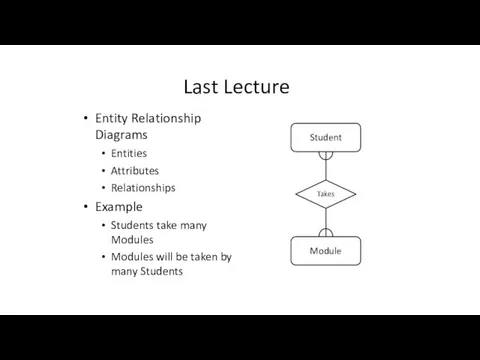
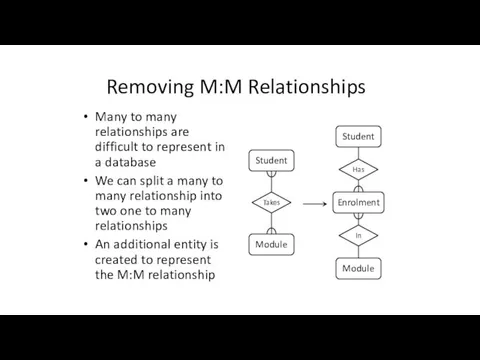

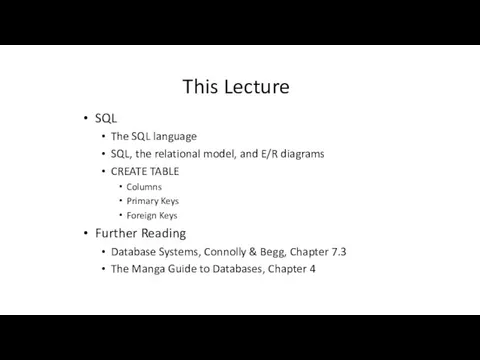
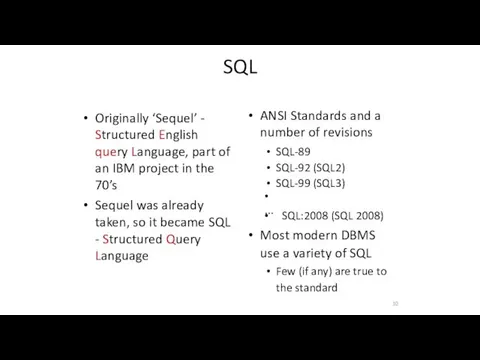
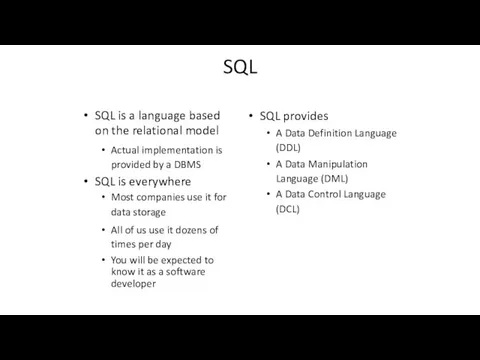
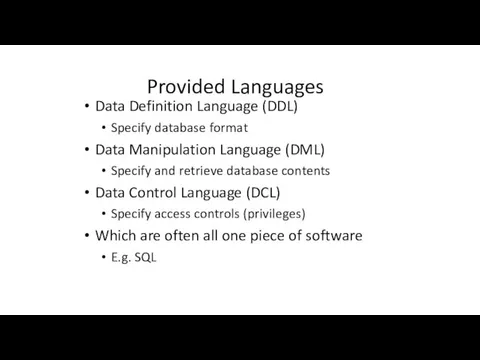
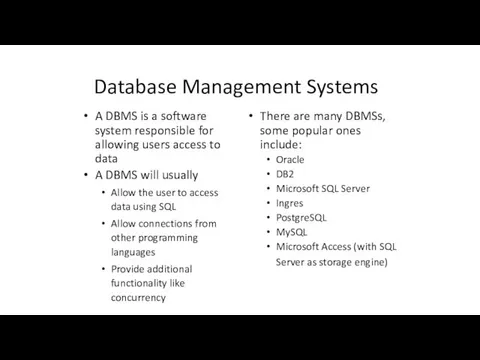
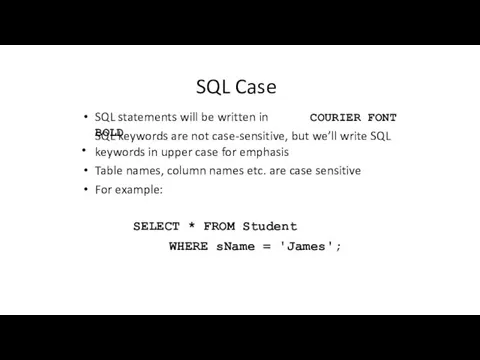
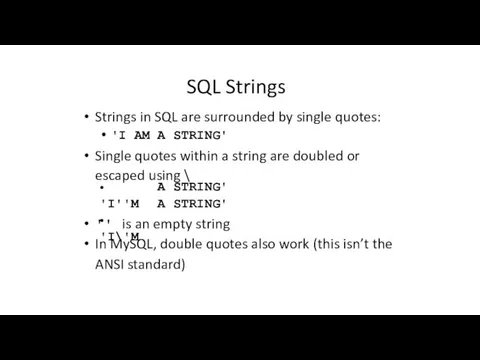
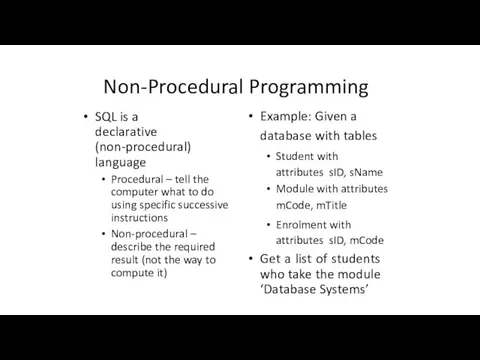
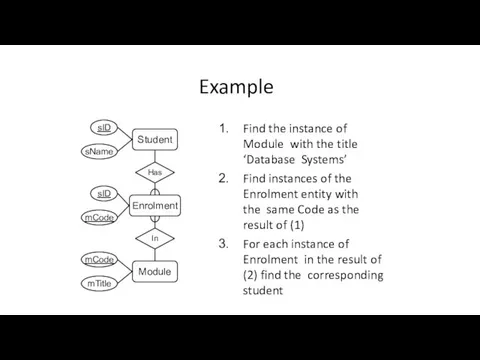
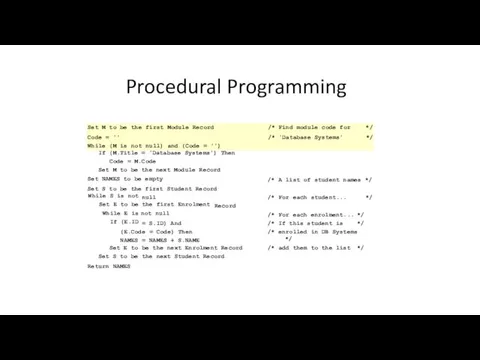
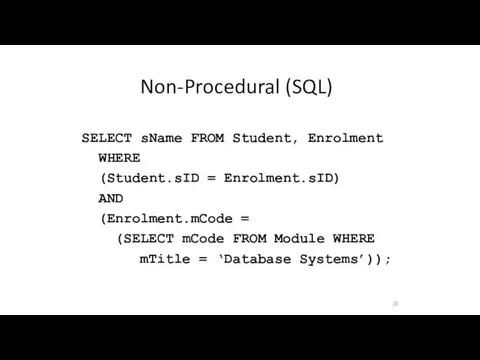
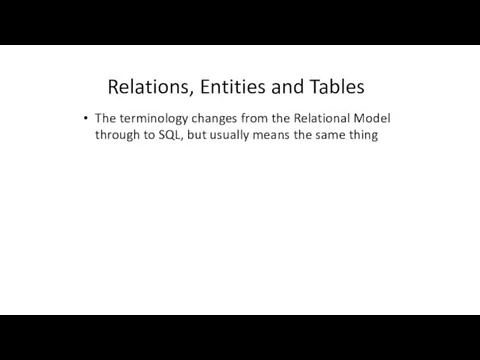
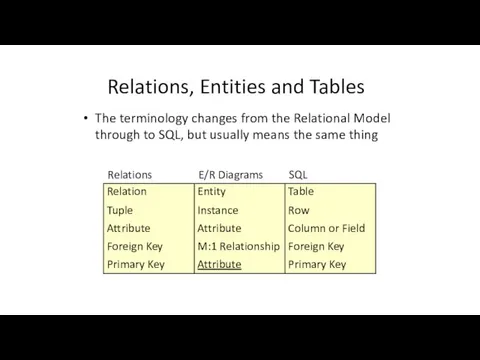
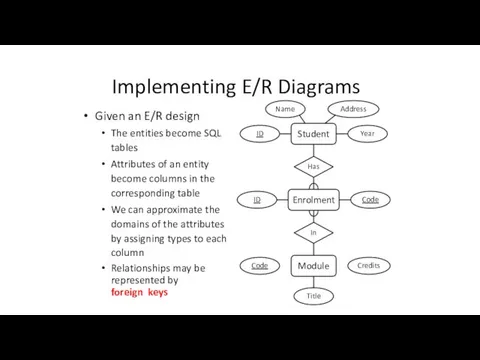
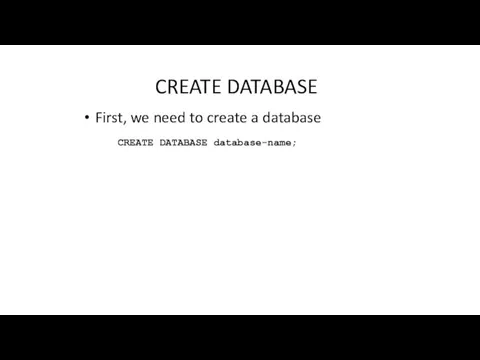
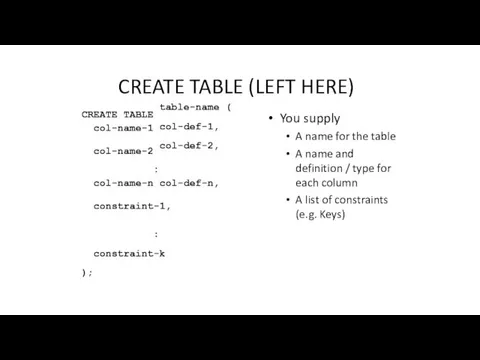
![Column Definitions col-name [NULL | col-def NOT NULL] [DEFAULT default_value]](/_ipx/f_webp&q_80&fit_contain&s_1440x1080/imagesDir/jpg/12232/slide-161.jpg)
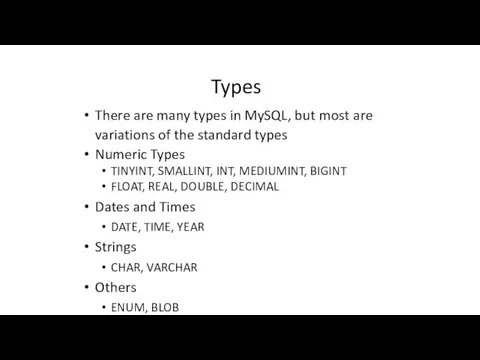
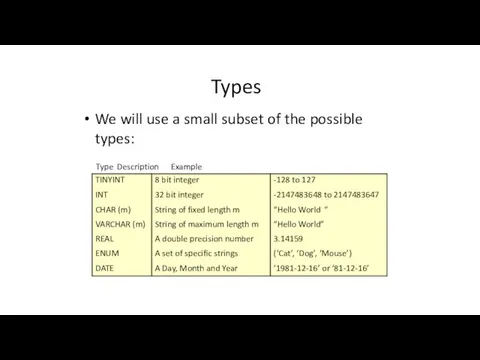
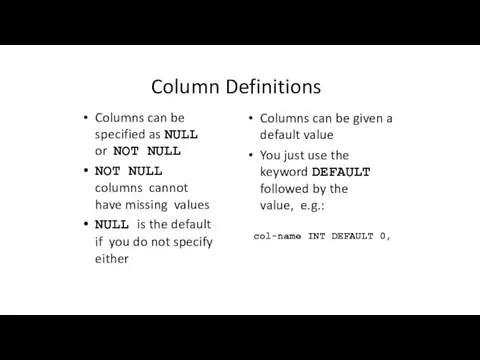
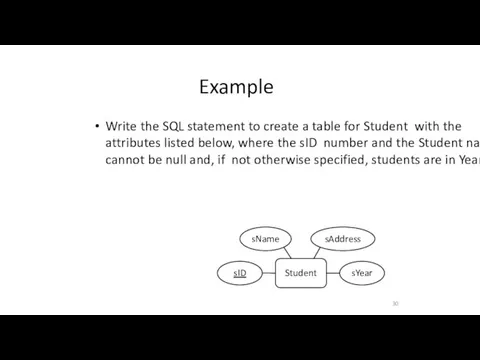
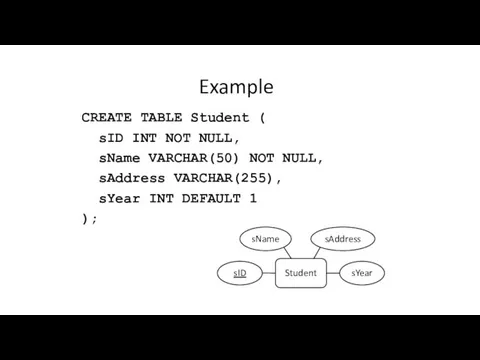
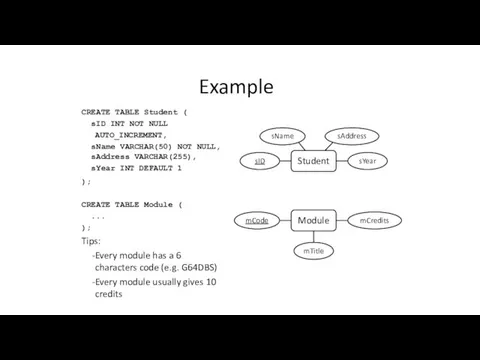
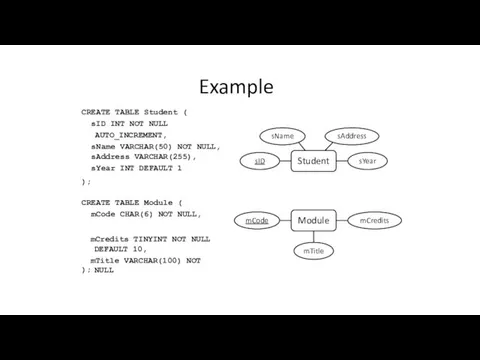
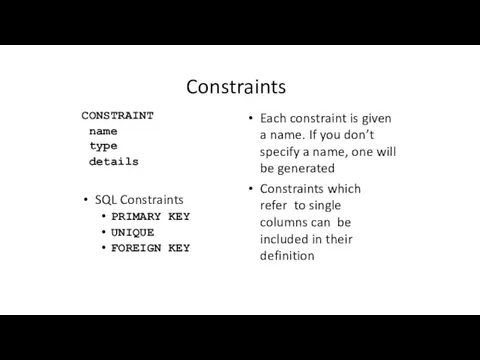
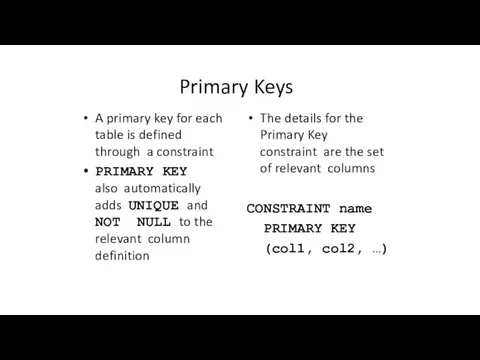
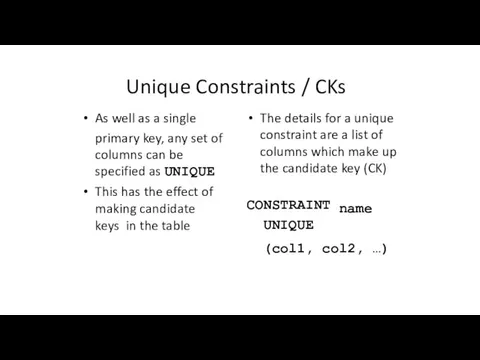
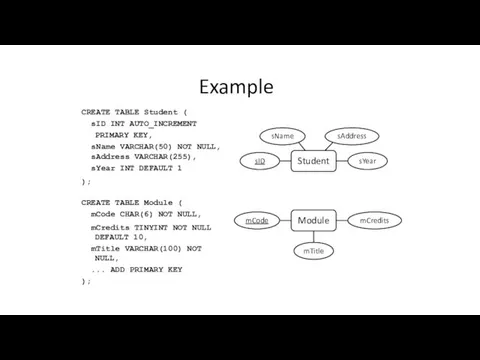

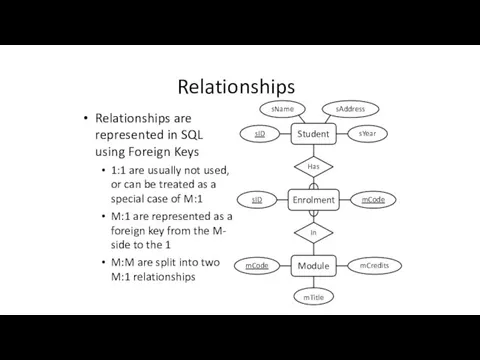
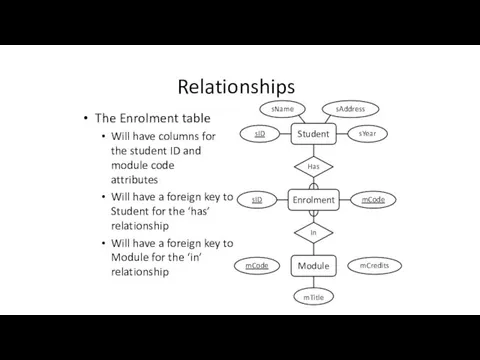
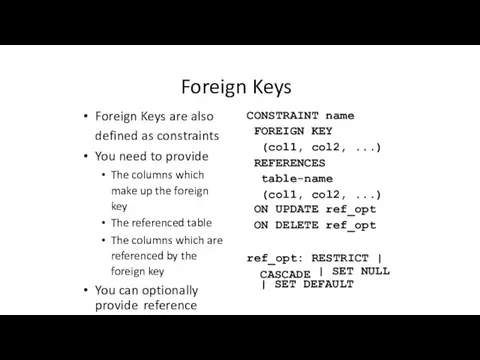
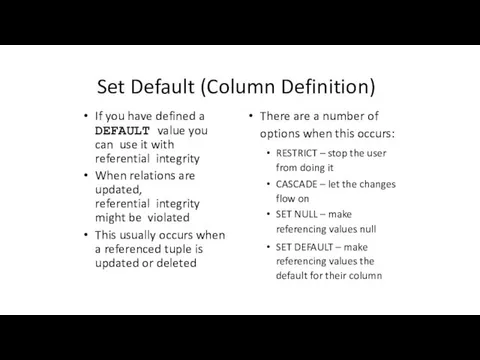
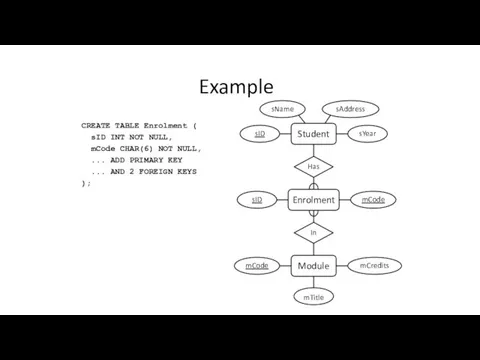
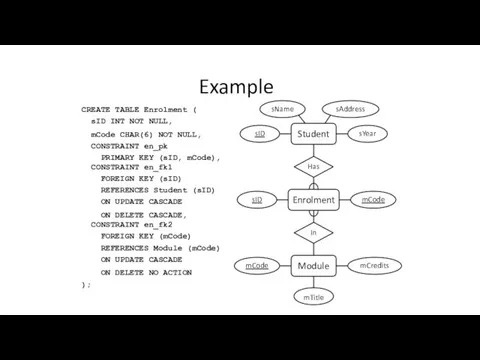
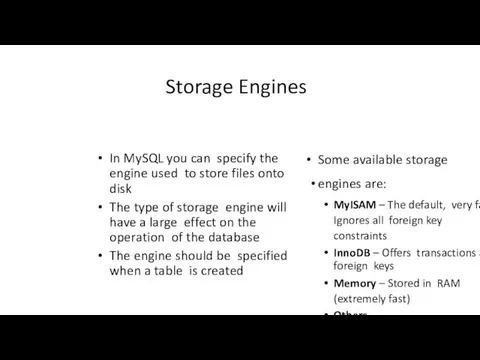
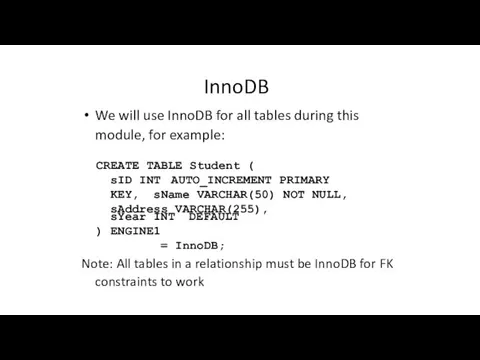
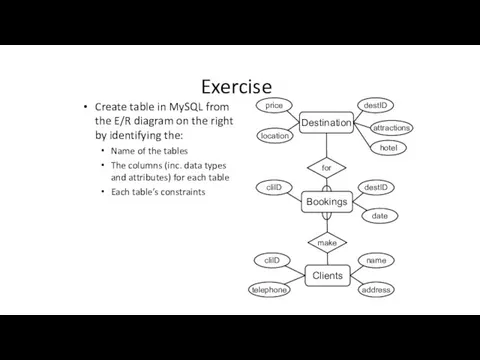
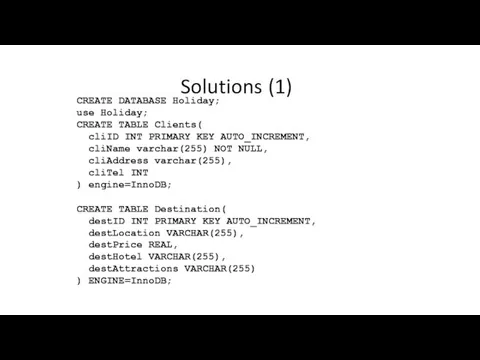
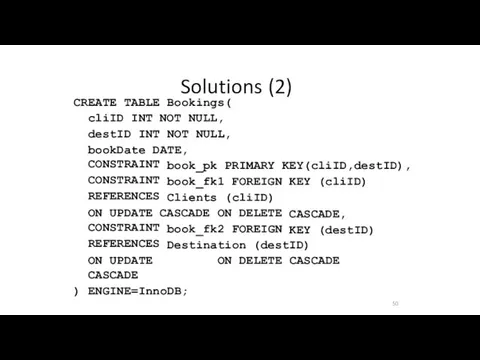
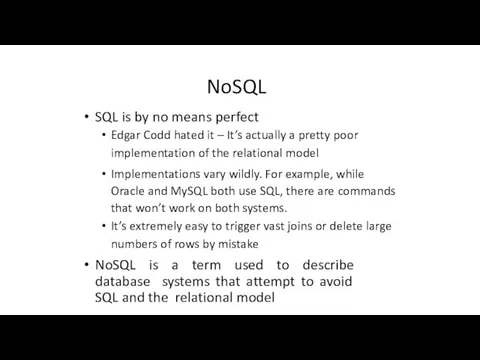
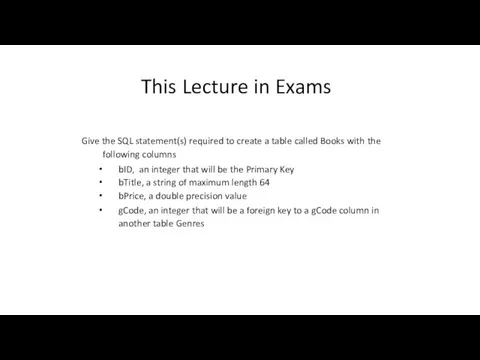
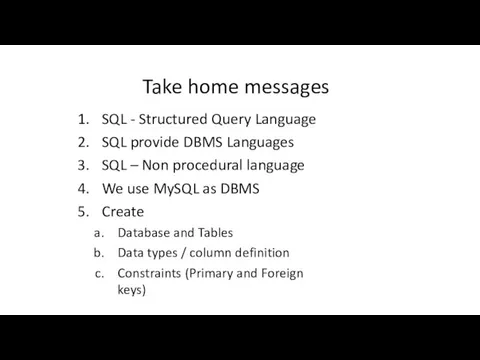

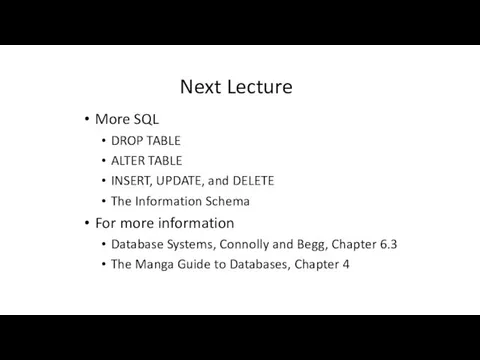
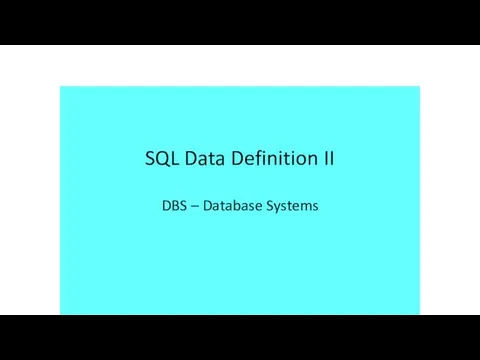

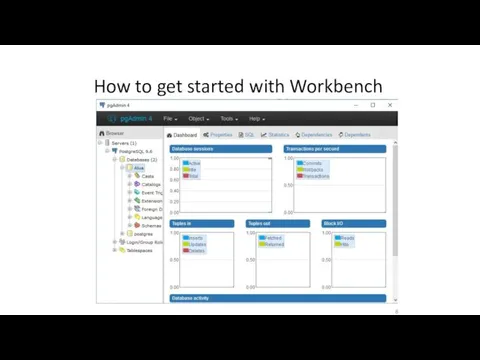
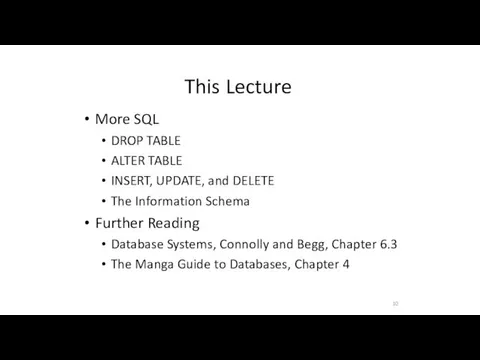
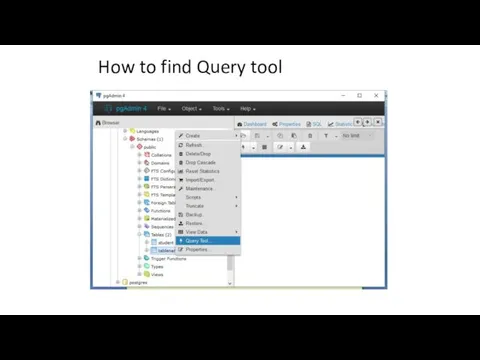
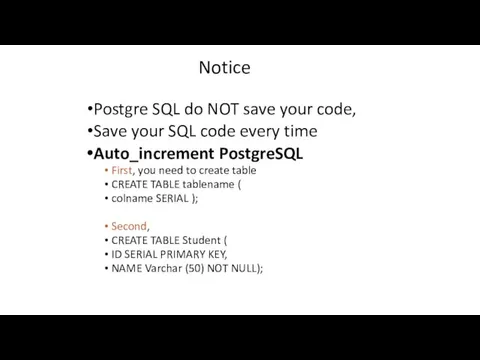
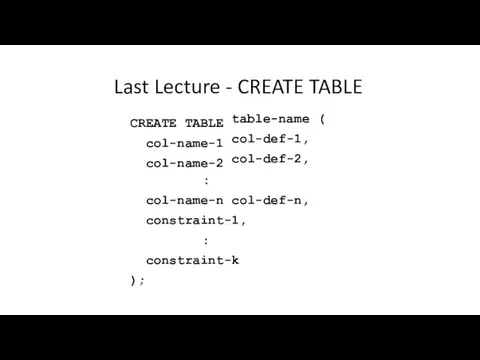
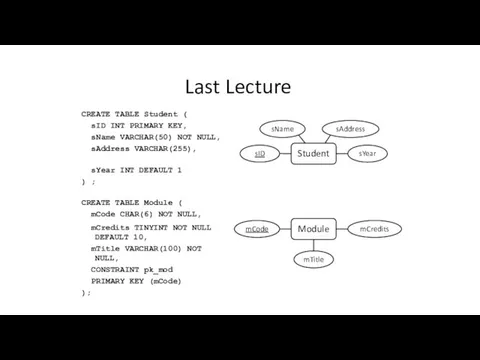
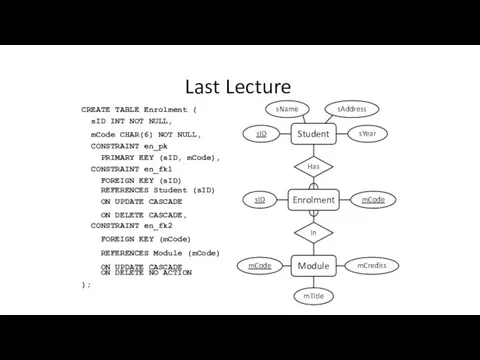
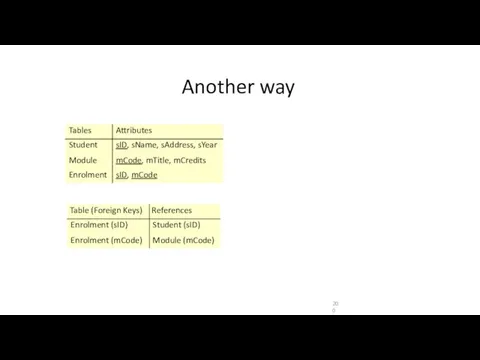

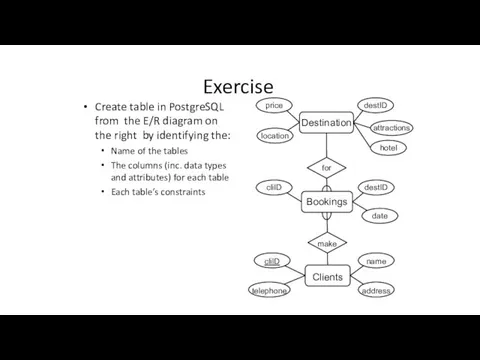
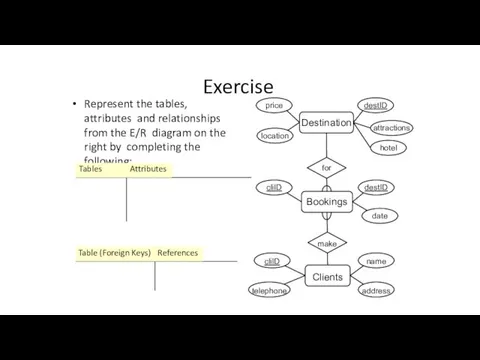

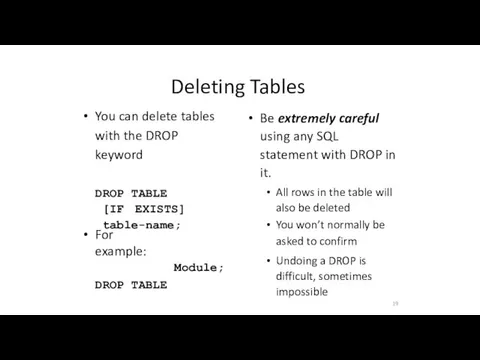
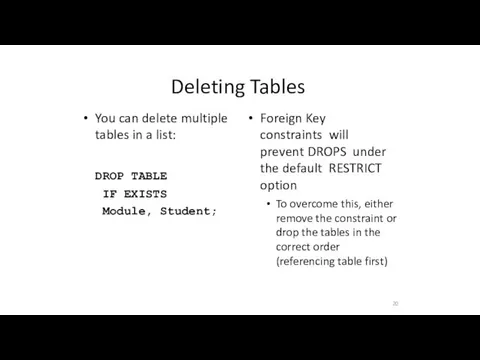
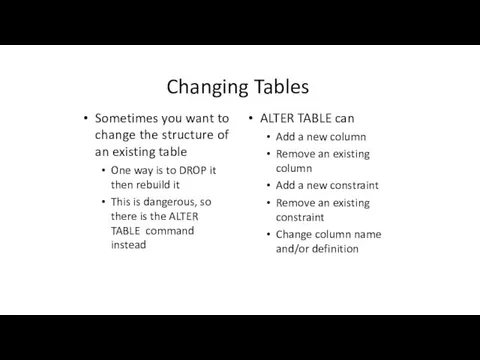
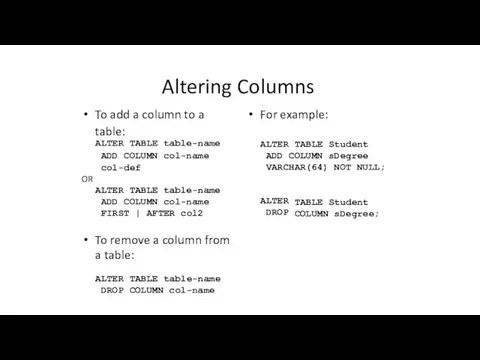
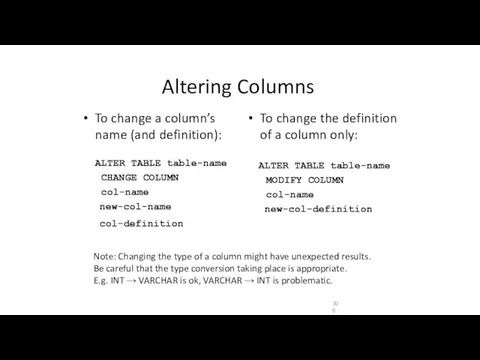
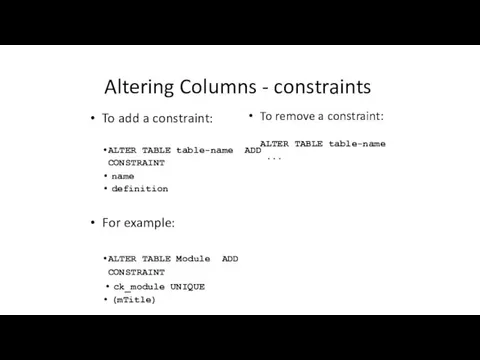
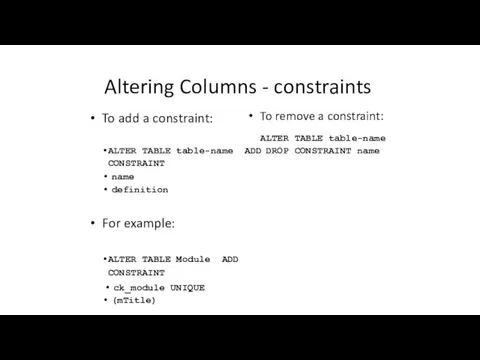
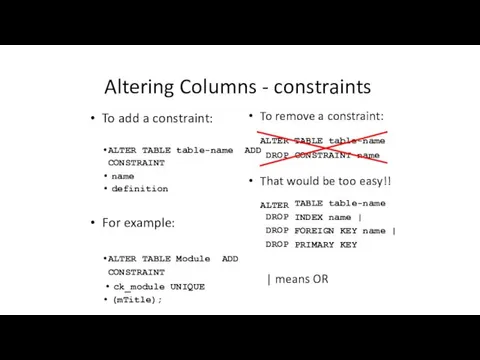
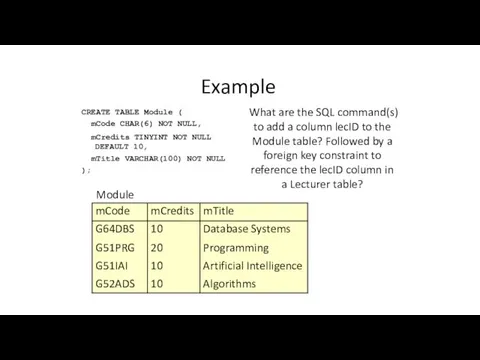
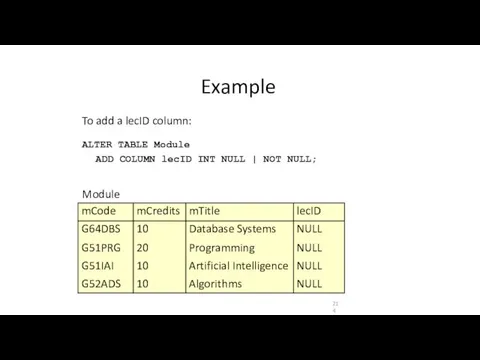
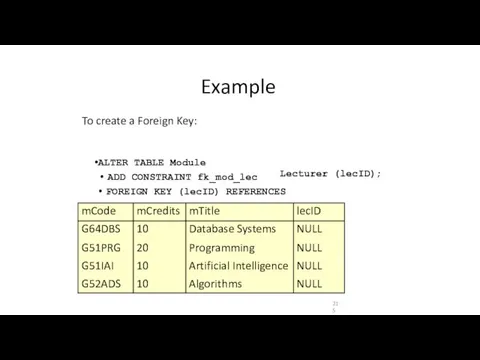
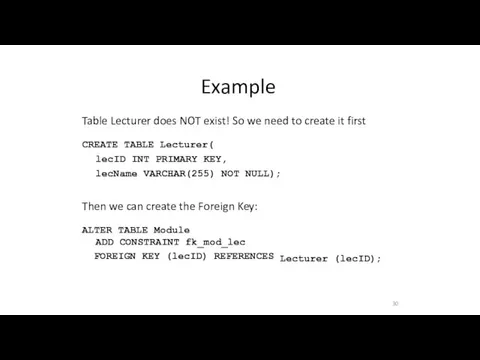
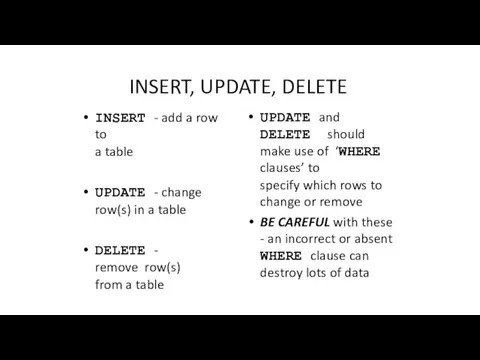
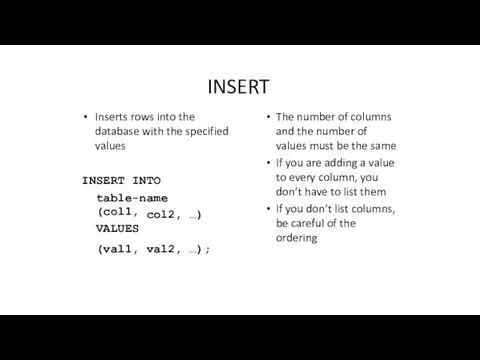
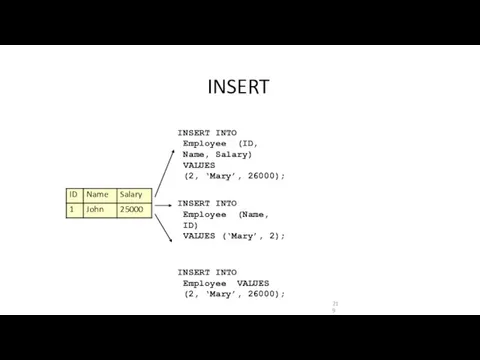
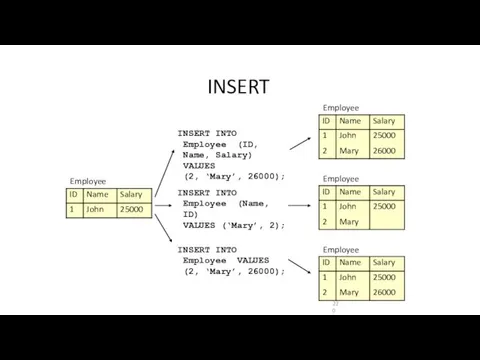
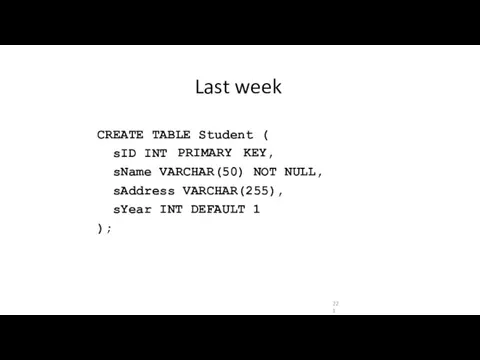

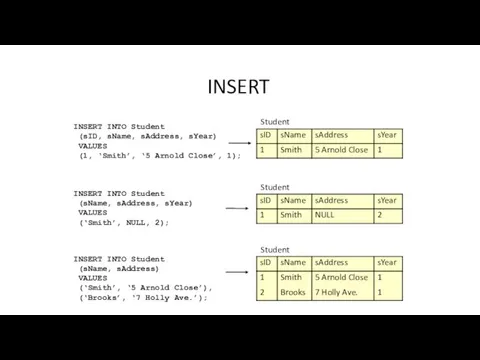
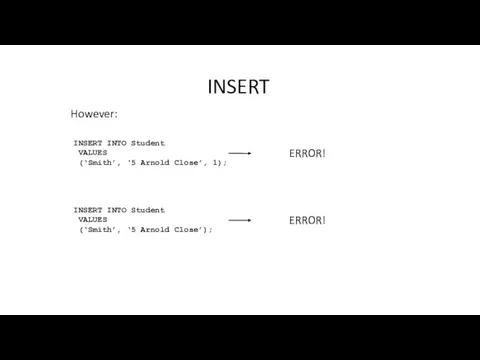
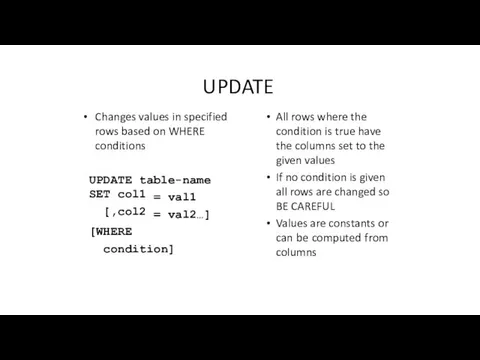
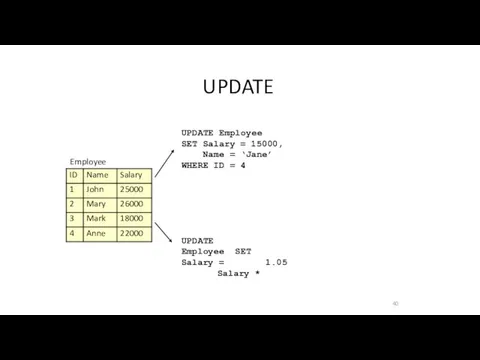
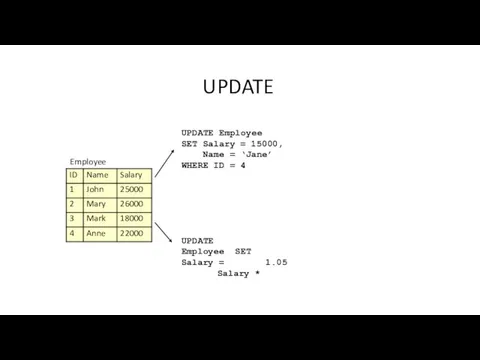
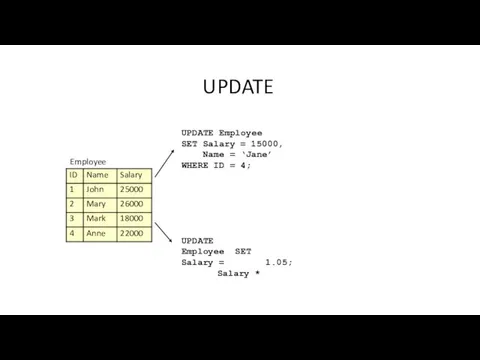
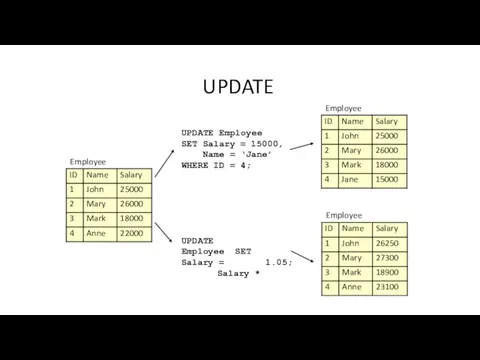

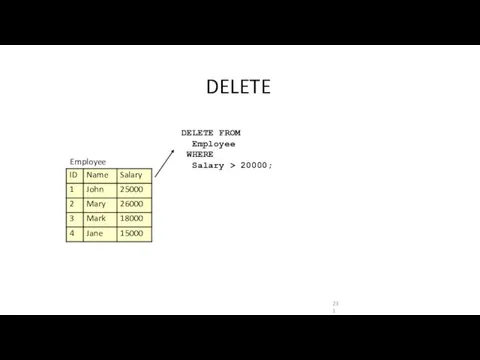
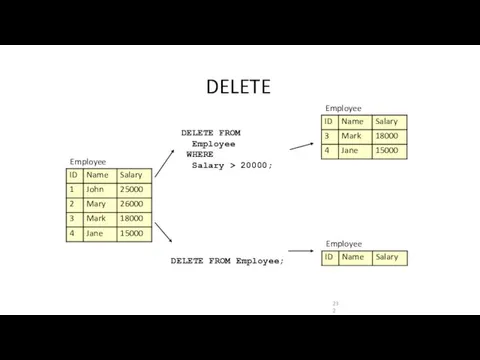
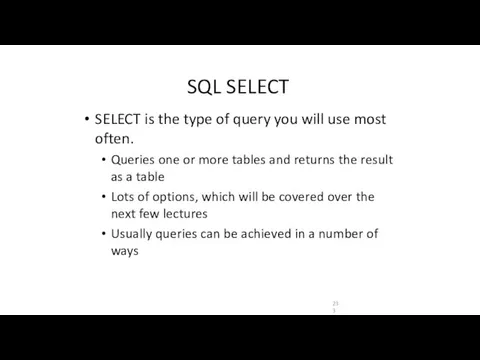
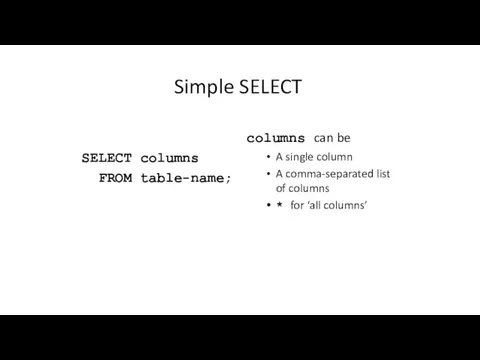
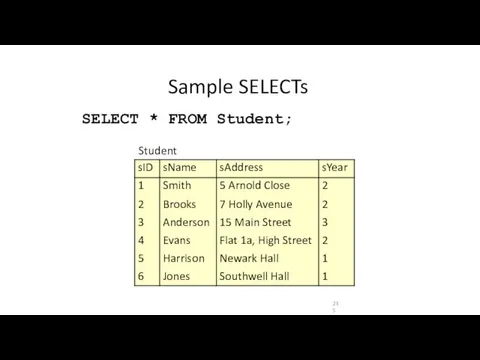
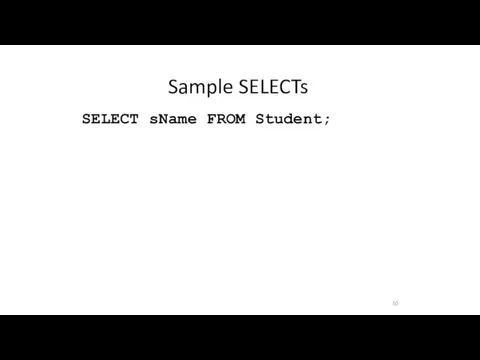
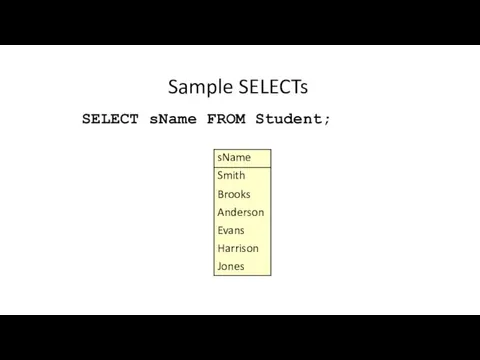
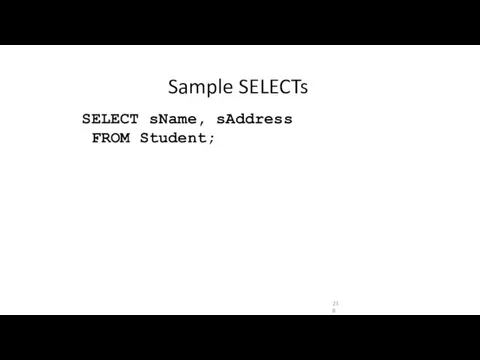
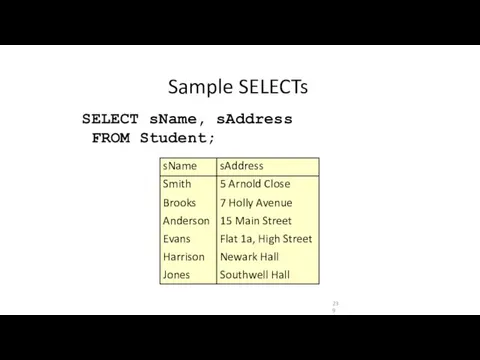
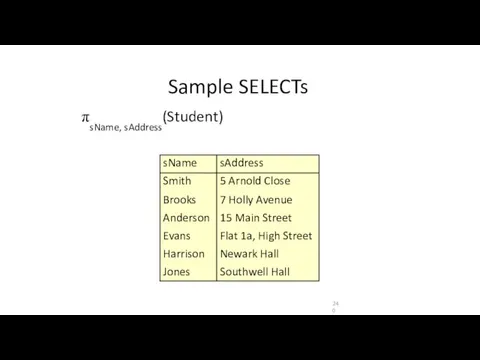
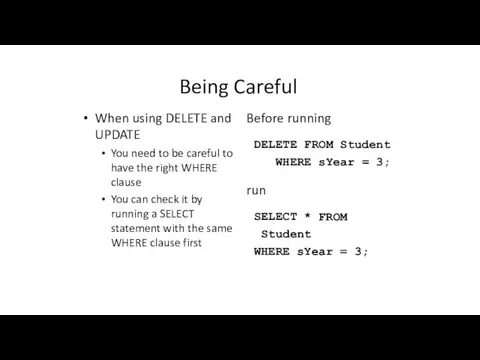

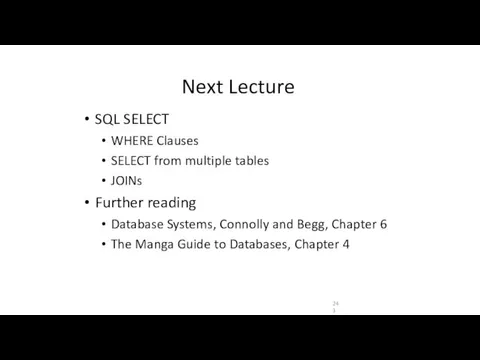
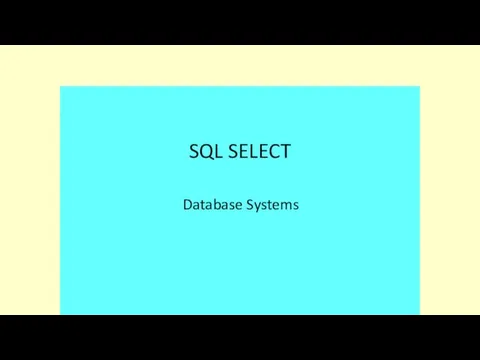

![SQL SELECT Overview SELECT [DISTINCT | ALL] column-list FROM table-names](/_ipx/f_webp&q_80&fit_contain&s_1440x1080/imagesDir/jpg/12232/slide-245.jpg)
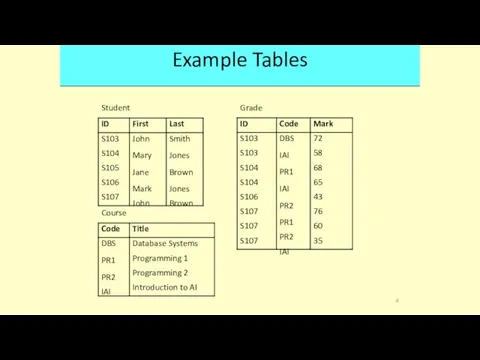
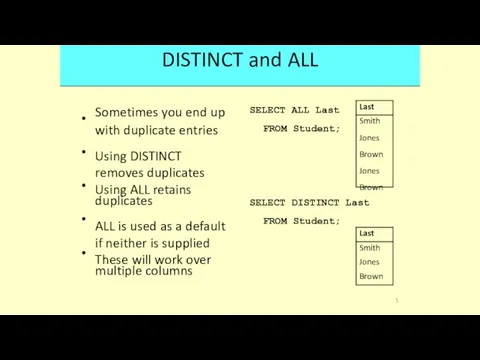
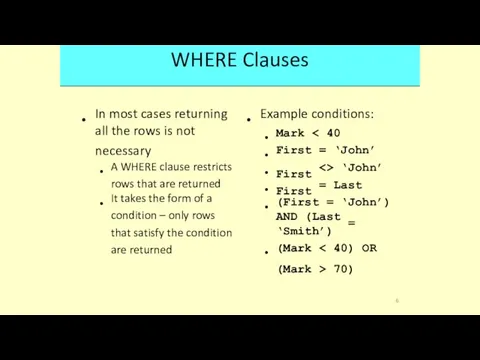
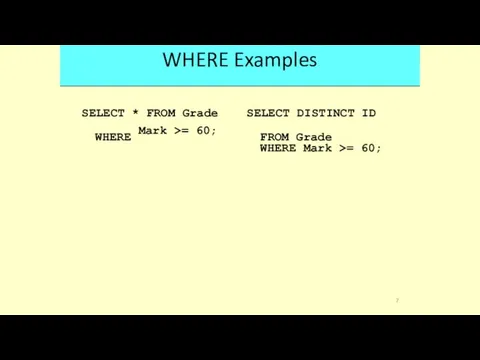
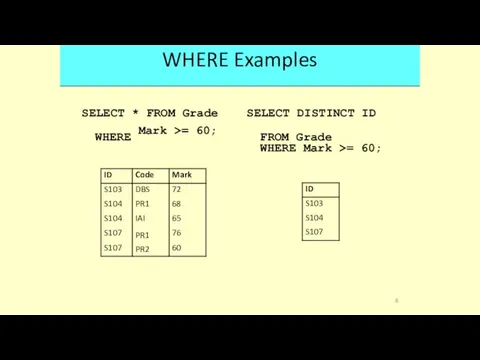
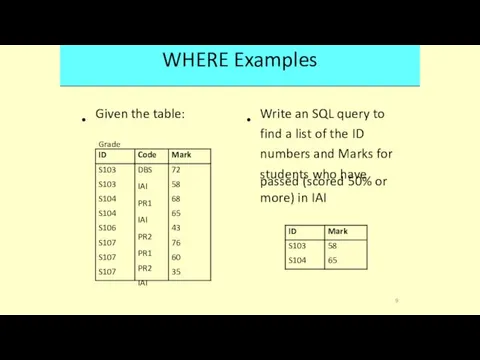
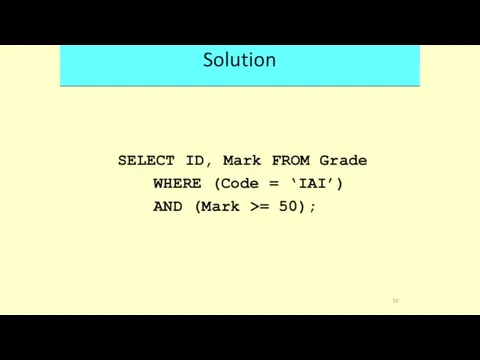
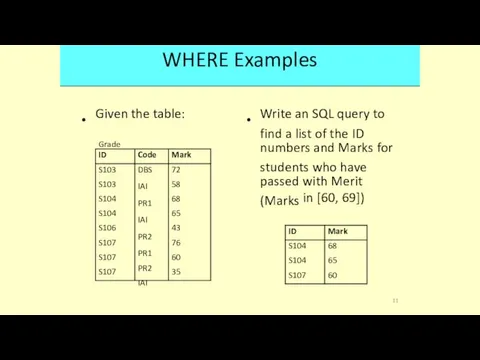
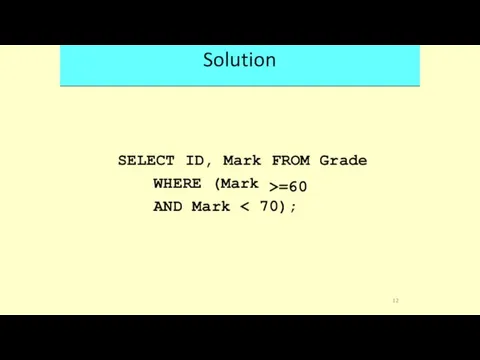
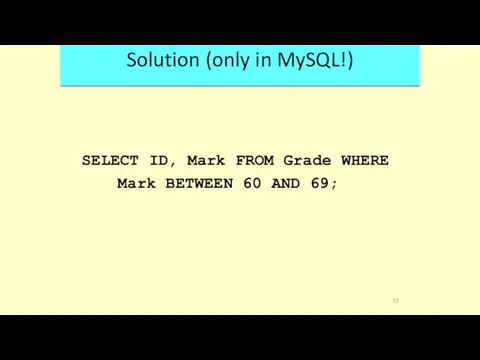
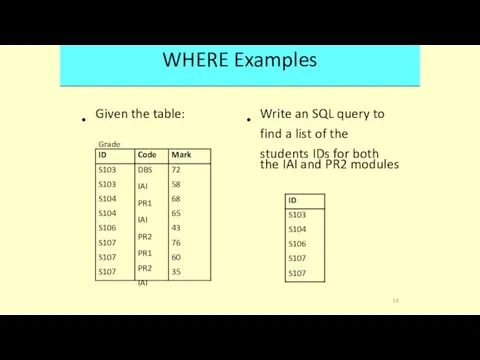
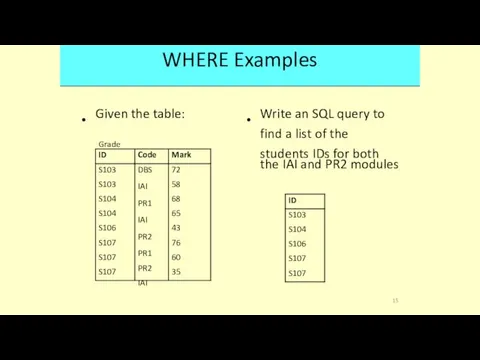
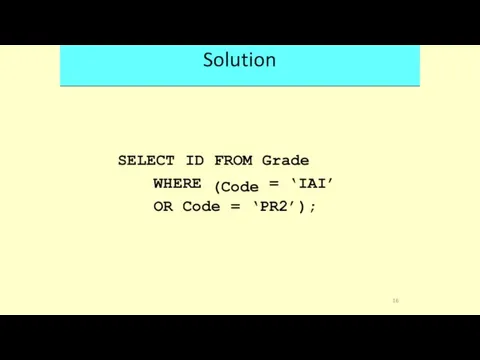
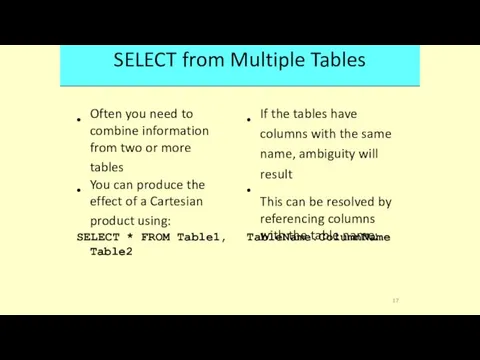
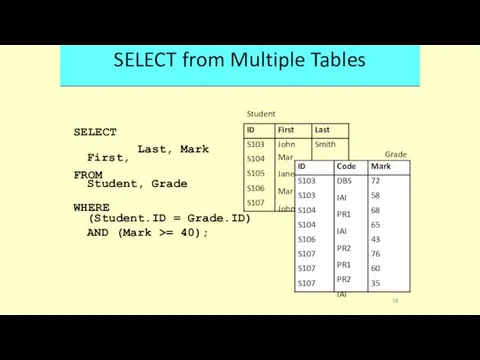
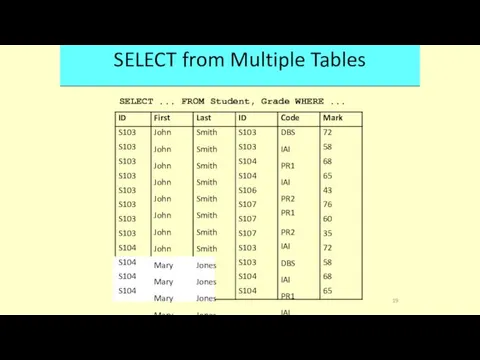
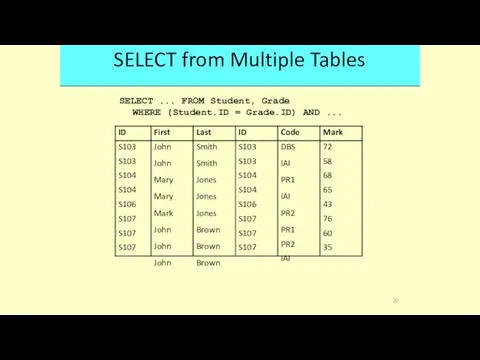
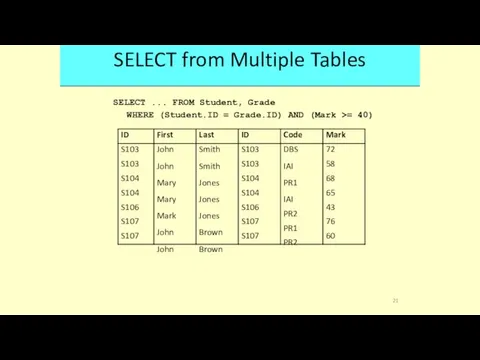
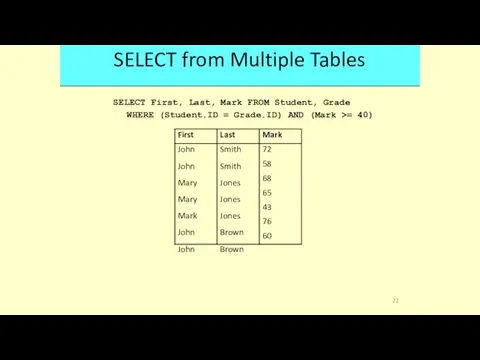
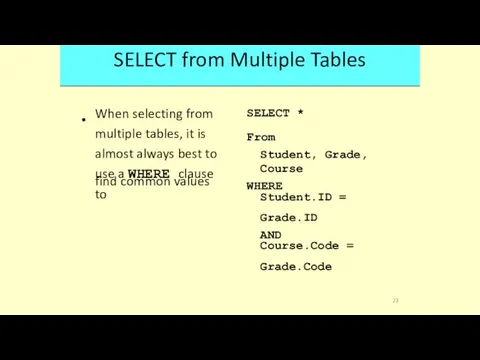
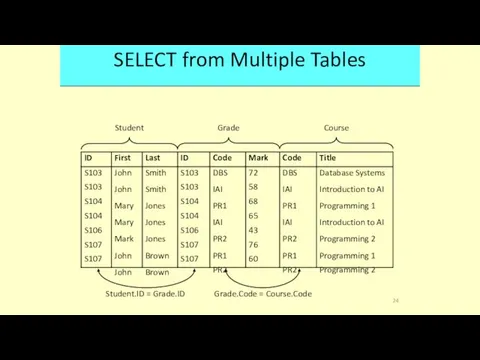
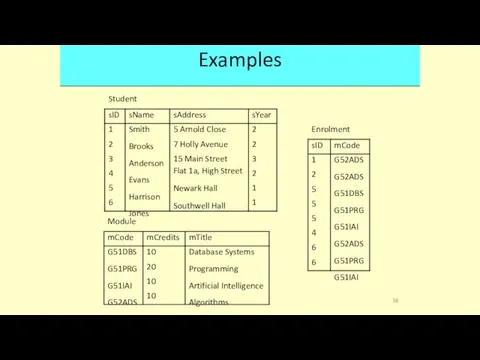
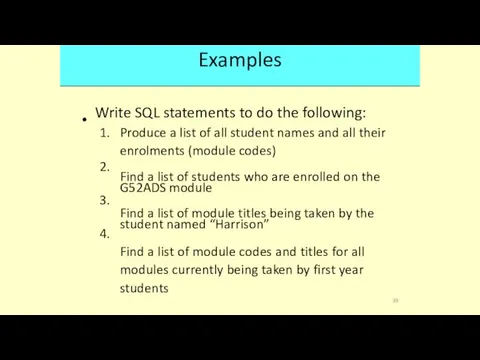
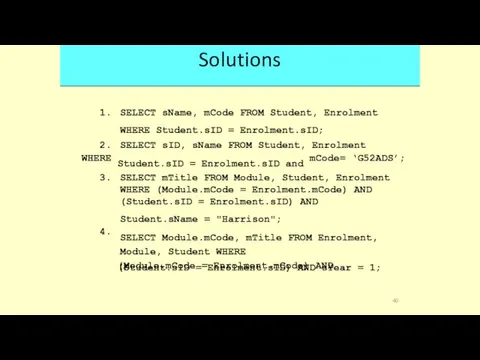
 Достоинства и недостатки волоконно-оптических линий связи
Достоинства и недостатки волоконно-оптических линий связи Easy Quizzy бағдарламасы арқылы автотест құру
Easy Quizzy бағдарламасы арқылы автотест құру Интеллектуальные системы. Введение в язык Prolog. (Лекция 1)
Интеллектуальные системы. Введение в язык Prolog. (Лекция 1) Корпоративные информационные системы
Корпоративные информационные системы Невербальное повествование сюжета в играх
Невербальное повествование сюжета в играх Электронное правительство
Электронное правительство Сайт ИнфоДа Moodle. Портал электронного обучения
Сайт ИнфоДа Moodle. Портал электронного обучения Проблемы и опыт ускоренной подготовки средств РТОП к крупным международным мероприятиям на аэродроме Казань
Проблемы и опыт ускоренной подготовки средств РТОП к крупным международным мероприятиям на аэродроме Казань Базы данных. Система управления базами данных
Базы данных. Система управления базами данных Oracle Application Express 5.1
Oracle Application Express 5.1 Язык программирования Delphi
Язык программирования Delphi Using Internet
Using Internet TV has important place in our lives
TV has important place in our lives Неиерархические классификации
Неиерархические классификации Правила хорошей презентации
Правила хорошей презентации Введение в CSS. Определение селекторов. Оформление текста
Введение в CSS. Определение селекторов. Оформление текста MyStat - электронный дневник студента
MyStat - электронный дневник студента Основы алгоритмики и логики в среде программирования Scratch
Основы алгоритмики и логики в среде программирования Scratch Проектная технология на уроках информатики
Проектная технология на уроках информатики Защита информации
Защита информации Организация службы IP-телефонии
Организация службы IP-телефонии Методическая разработка Использование функций в табличном процессоре MS Exel
Методическая разработка Использование функций в табличном процессоре MS Exel Аппаратное обеспечение пк
Аппаратное обеспечение пк Инструкция Zoom (1)
Инструкция Zoom (1) Загальні відомості про електронну комерцію
Загальні відомості про електронну комерцію Форма и элементы управления. Пользовательская форма в приложении
Форма и элементы управления. Пользовательская форма в приложении MS Windows операциялық жүйесі ОЖ
MS Windows операциялық жүйесі ОЖ Этапы решения задач на компьютере. языки программирования.
Этапы решения задач на компьютере. языки программирования.